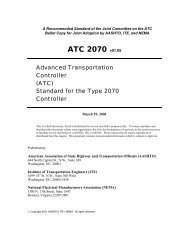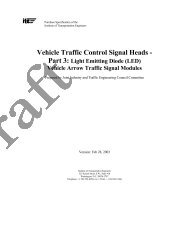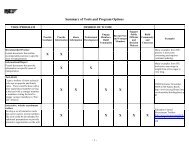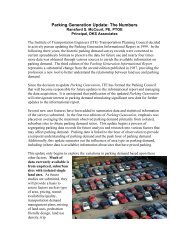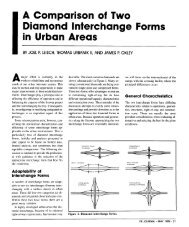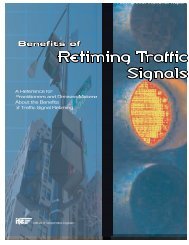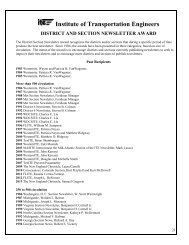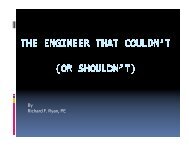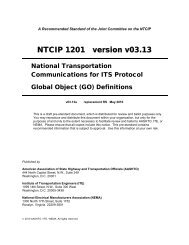Vehicle Traffic Control Signal Heads: - Institute of Transportation ...
Vehicle Traffic Control Signal Heads: - Institute of Transportation ...
Vehicle Traffic Control Signal Heads: - Institute of Transportation ...
You also want an ePaper? Increase the reach of your titles
YUMPU automatically turns print PDFs into web optimized ePapers that Google loves.
2.12 Power Consumption. The electrical power<br />
in watts consumed by a module when operated at<br />
nominal operating voltage and ambient operating<br />
temperature range.<br />
2.13 Power Factor. The power factor equals<br />
watts divided by volt-ampere or the ratio <strong>of</strong> power<br />
consumption in watts to volt-amperes.<br />
2.14 Total Harmonic Distortion (THD). THD is<br />
the ratio <strong>of</strong> the root-mean-square (RMS) value <strong>of</strong><br />
the harmonics to the amplitude <strong>of</strong> the fundamental<br />
component <strong>of</strong> the AC waveform.<br />
2.15 Translate. To move an object along a linear<br />
vector, such that the orientation <strong>of</strong> the object does<br />
not rotate relative to the original frame <strong>of</strong><br />
reference.<br />
2.16 Turn OFF Time. The amount <strong>of</strong> time<br />
required after removal <strong>of</strong> the nominal operating<br />
voltage for the LED signal module to show no<br />
visible illumination.<br />
2.17 Turn OFF Voltage. The voltage below<br />
which the LED signal module emits no visible<br />
illumination.<br />
2.18 Turn ON Time. The amount <strong>of</strong> time<br />
required for the LED signal module to reach 90<br />
percent <strong>of</strong> full illumination.<br />
2.19 Volt-Amperes. The product <strong>of</strong> the rootmean-square<br />
(RMS) line voltage and RMS line<br />
current, measured with true RMS meters.<br />
3. Physical and Mechanical<br />
Requirements<br />
3.1 General<br />
3.1.1 Modules shall fit into existing traffic signal<br />
housings built to the VTCSH Standard without<br />
modification to the housing, or shall be standalone<br />
units that incorporate a housing meeting the<br />
performance and design requirements <strong>of</strong> the<br />
VTCSH Standard.<br />
3.1.2 Installation <strong>of</strong> a module into an existing<br />
signal housing shall not require the use <strong>of</strong> special<br />
tools. The module shall connect directly to<br />
existing electrical wiring system.<br />
3.2 LED <strong>Signal</strong> Module<br />
3.2.1 A module shall be capable <strong>of</strong> replacing the<br />
existing optical components or signal module in a<br />
signal housing, or shall provide a complete<br />
replacement <strong>of</strong> the signal head.<br />
3.2.2 The module lens shall be hard coated or<br />
otherwise made to comply with the material<br />
exposure and weathering effects requirements <strong>of</strong><br />
the Society <strong>of</strong> Automotive Engineers (SAE) J576.<br />
3.2.3 Tinting (Optional)—The lens may be tinted<br />
or covered by transparent film or materials with<br />
similar color and transmissive characteristics.<br />
3.2.4 The module lens may be a replaceable part,<br />
without the need to replace the complete LED<br />
signal module.<br />
3.3 Environmental Requirements<br />
3.3.1 All exposed components <strong>of</strong> a module shall<br />
be suitable for prolonged exposure to the<br />
environment, without appreciable degradation that<br />
would interfere with function or appearance. As a<br />
minimum, selected materials shall be rated for<br />
service for a period <strong>of</strong> a minimum <strong>of</strong> 60 months in<br />
a south-facing Arizona Desert installation.<br />
3.3.2 A module shall be rated for use throughout<br />
an ambient operating temperature range,<br />
measured at the exposed rear <strong>of</strong> the module, <strong>of</strong><br />
-40°C (-40°F) to +74°C (+165°F).<br />
3.3.3 A module shall be protected against dust and<br />
moisture intrusion, including rain and blowing<br />
rain.<br />
3.3.4 The module lens shall not crack, craze, or<br />
yellow due to solar UV irradiation typical for a<br />
south-facing Arizona Desert installation after a<br />
minimum <strong>of</strong> 60 months in service.<br />
2



